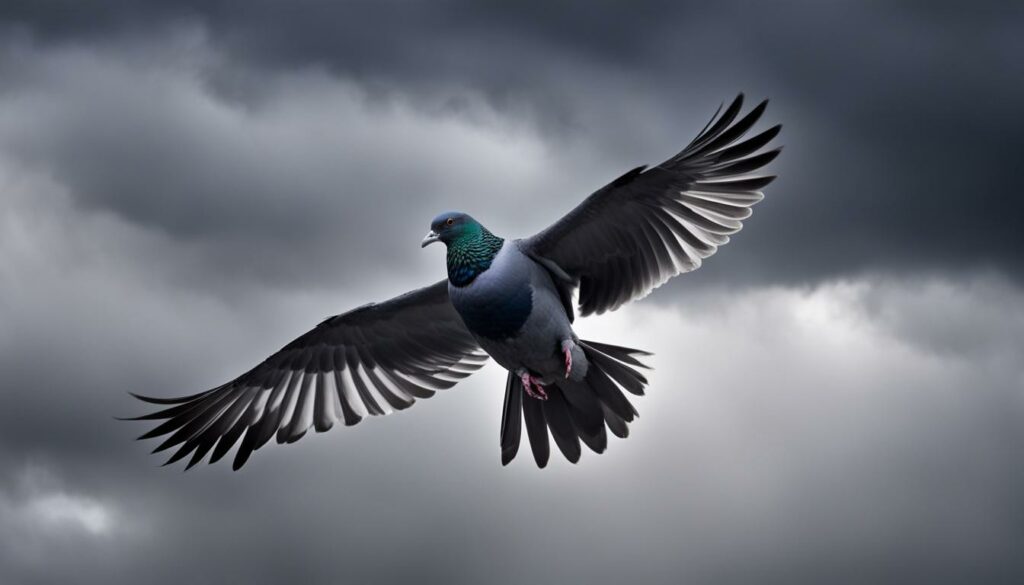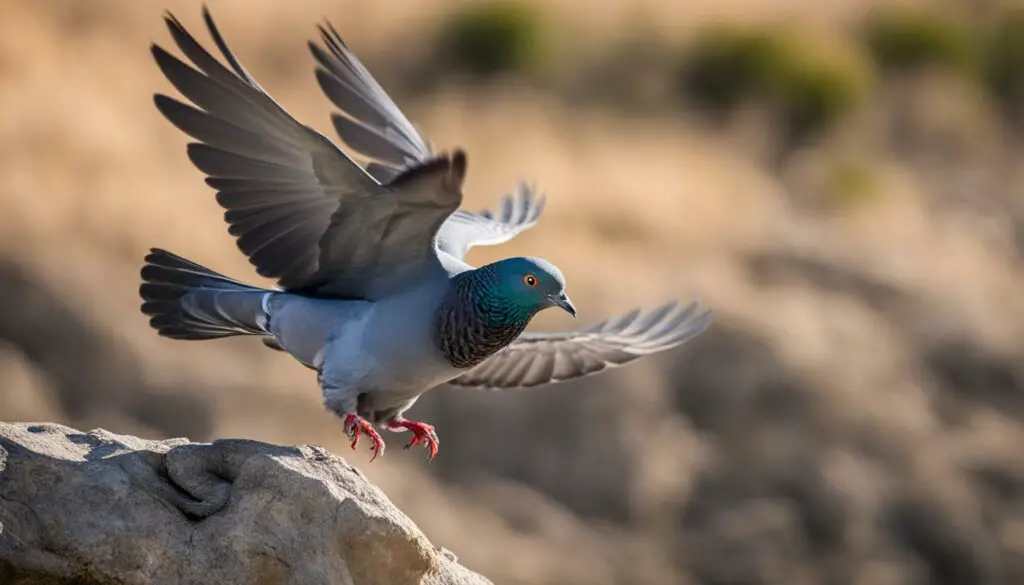Pigeons have always amazed me with their exceptional navigational skills. These remarkable birds have been used as messengers, communication tools, and athletes in international races for thousands of years. However, there are instances where pigeons seem to get confused and fly in the wrong direction or scatter randomly. It’s intriguing to explore the theories behind their homing abilities and understand the factors that contribute to their extraordinary navigation.
Key Takeaways:
- Pigeons possess incredible homing abilities that have been prized for centuries.
- One theory suggests that pigeons use ultralow frequency sounds to navigate.
- Infrasound, sound waves below the range of human hearing, plays a crucial role in pigeon navigation.
- Release-site biases and weather conditions can affect the pigeons’ navigational accuracy.
- Pigeons may use a combination of infrasound, landmarks, and other mechanisms to find their way home.
The Science Behind Pigeon Homing
As a journalist fascinated by the incredible navigational abilities of pigeons, I dove into the world of pigeon navigation to uncover the secrets behind their homing skills. While scientists have long debated whether pigeons use their sense of smell or Earth’s magnetic field lines to find their way home, a groundbreaking theory proposes a different mechanism.
Geophysicist Jon Hagstrum suggests that pigeons rely on infrasound, which are sound waves below the range of human hearing, to create a mental map of their surroundings and navigate back to their lofts. This theory challenges the traditional explanations and opens up new possibilities for understanding pigeon navigation.
To shed light on the role of infrasound in pigeon navigation, Hagstrum conducted extensive research. He found that infrasound waves, which pigeons can detect, allow them to “image” the terrain surrounding their lofts. Similar to how humans visually recognize their house using their eyes, pigeons use infrasound to create a mental picture of their environment and navigate accurately most of the time.
Further research is needed to fully understand the intricacies of pigeon navigation and uncover additional mechanisms at play. The exploration of pigeon navigation not only provides insights into the behavior of these remarkable birds but also presents opportunities for advancements in navigation technology for humans.
| Key Points | Details |
|---|---|
| Pigeon Navigation Skills | Pigeons have long been admired for their ability to find their way home over long distances. |
| Pigeon Navigation System | The traditional theories of smell and magnetic fields are challenged by the infrasound theory proposed by Jon Hagstrum. |
| Infrasound and Mental Mapping | Infrasound waves allow pigeons to create a mental map of their surroundings and navigate accurately. |
| Research and Advancements | Further exploration of pigeon navigation could lead to advancements in navigation technology for humans. |
The Role of Infrasound in Pigeon Navigation
When it comes to the homing instinct in pigeons and how they find their way, the role of infrasound cannot be overlooked. Infrasound waves, which are below the range of human hearing, play a crucial role in helping pigeons navigate their surroundings and find their way back to their lofts.
Pigeons have the incredible ability to detect and interpret infrasound waves. These waves allow them to create a mental map of the terrain surrounding their loft, just like humans recognize their house using their eyes. By picking up on these infrasound signals, pigeons can navigate accurately most of the time.
However, disruptions in the infrasound waves can cause disorientation in pigeons. Certain areas where these waves are disrupted can lead to pigeons flying in the wrong direction or scattering randomly. Understanding the impact of infrasound on pigeon navigation can provide valuable insights into their homing instinct and help researchers uncover further mysteries surrounding their remarkable abilities.
Pigeon Migration Patterns and Navigational Abilities
When it comes to pigeon navigation, researchers have long been captivated by their remarkable abilities to find their way home over long distances. However, there are certain areas where pigeons seem to struggle, leading to disorientation and confusion. These areas are known as release-site biases, where pigeons consistently face navigational challenges.
To understand release-site biases and their impact on pigeon navigation, researchers have conducted numerous studies. One such study observed that pigeons released from specific locations, like Castor Hill and Jersey Hill in upstate New York, often fly in the wrong direction or scatter randomly when attempting to return to their lofts. Interestingly, pigeons from other lofts released at these same sites show no navigation issues. This suggests that something specific about these locations is causing the disorientation.
One possible explanation for release-site biases is the disruption of infrasound waves, which pigeons use to create mental maps of their surroundings. Infrasound waves propagate at frequencies below what we can hear, but pigeons have the unique ability to detect them. These waves allow pigeons to “image” the terrain surrounding their loft, much like humans rely on visual recognition. Disruptions in infrasound transmission at release sites could explain why pigeons struggle to navigate accurately in certain areas.

Release-Site Biases and Infrasound Disruption
Further research is needed to explore the specific factors that contribute to release-site biases and infrasound disruption in pigeon navigation. Understanding this phenomenon could have significant implications for our knowledge of pigeon migratory patterns and their navigational abilities. By gaining insights into the challenges they face, researchers can uncover new strategies for improving navigation systems, both for pigeons and potentially for humans.
The Role of Infrasound in Release-Site Biases
Pigeon race navigation is a complex process influenced by various factors. One intriguing aspect is the role of infrasound in release-site biases. Infrasound waves, which are below the range of human hearing, play a crucial role in pigeons’ ability to locate their home. Jon Hagstrum’s research has shed light on how infrasound affects pigeon navigation and why some release sites pose navigational challenges.
One example is the release site at Jersey Hill, where the normal conditions create a sound shadow that prevents infrasounds from the Cornell loft, the pigeons’ destination, from reaching the release site. However, under certain weather conditions, such as changing wind patterns and temperature inversions, the transmission of infrasound is permitted. As a result, the pigeons have no trouble finding their way home on these particular days.
| Release Site | Infrasound Transmission |
|---|---|
| Jersey Hill | Normal conditions create a sound shadow |
| Jersey Hill (particular day with changing wind patterns and temperature inversions) | Infrasound transmission permitted |
This table illustrates the contrast between normal conditions and specific weather patterns at Jersey Hill. The presence or absence of infrasound at release sites can determine whether pigeons experience disorientation or navigate successfully. These findings highlight the significance of infrasound in the release-site biases observed in pigeon race navigation.
Pigeon Navigational Abilities and Atmospheric Conditions
When it comes to pigeon navigation, the terrain and atmospheric conditions play a crucial role. Pigeons rely on a combination of mechanisms, including infrasound, compass mechanisms, and familiar landmarks, to find their way home over long distances. However, the interaction between these mechanisms and the surrounding environment can significantly impact their navigational abilities.
One fascinating aspect is how the topography and normal atmospheric conditions can affect the transmission of infrasound waves. Infrasounds, which are sound waves below the range of human hearing, allow pigeons to “image” the terrain surrounding their loft. But in certain areas, these waves may bounce up and over, approach from different directions, or be disrupted by atmospheric conditions, leading to navigational challenges for the pigeons.
To illustrate the impact of atmospheric conditions on pigeon navigation, consider the study conducted by Jon Hagstrum. He found that on one particular day with changing wind patterns and temperature inversions, the transmission of infrasound waves at a release site was permitted. As a result, the pigeons had no trouble finding their way home. This highlights how even minor changes in atmospheric conditions can have a significant influence on their navigational abilities.
| Factors | Impact on Pigeon Navigation |
|---|---|
| Topography | Affects the propagation of infrasound waves, leading to navigational challenges |
| Normal Atmospheric Conditions | Can disrupt the transmission of infrasound waves, causing disorientation |
| Wind Patterns and Temperature Inversions | Can affect the arrival of infrasound from unexpected directions, leading to navigational challenges |
Understanding the interplay between pigeon navigational abilities and atmospheric conditions is crucial for researchers and pigeon racers alike. It allows them to anticipate and account for the challenges that pigeons may face during races or long-distance flights. By unraveling the intricacies of pigeon navigation, we gain valuable insights into the fascinating world of these remarkable birds.

Pigeon Navigational Abilities: Multiple Maps for Navigation
When it comes to pigeon navigation, there is growing evidence that these birds may rely on multiple maps depending on their geographical location. Cordula Mora, an animal behavior researcher, suggests that some pigeons may use their sense of smell, while others may rely more on infrasound or even magnetic fields.
This variation in navigational methods may be due to the environment the pigeons were raised in. Just as humans have different ways of navigating based on their surroundings, pigeons may adapt their navigational strategies to best suit their specific location.
Infrasound, in particular, plays a significant role in pigeon navigation. These low-frequency sound waves allow pigeons to “image” the terrain surrounding their loft, creating a mental map of their surroundings. By detecting infrasound, pigeons can accurately navigate most of the time, although disruptions in these waves can cause disorientation in certain areas.
While much is still unknown about the exact mechanisms of pigeon navigation, the concept of multiple maps offers valuable insights into their navigational abilities. Further research is needed to fully understand how pigeons adapt their navigational methods and how different environmental factors influence their choices.
“Pigeons may rely on different maps for navigation based on their geographical location and the environment they were raised in.”
Pigeon Navigational Abilities and Weather Conditions
Weather conditions play a crucial role in the navigational abilities of pigeons. Wind patterns and temperature inversions can significantly impact their ability to navigate accurately over long distances. Abnormal weather conditions on certain days can disrupt the transmission of infrasound waves, which are essential for pigeons to create mental maps of their surroundings.
For example, changing wind patterns and temperature inversions can alter the direction and arrival of infrasound waves at release sites. This can cause pigeons to experience navigational challenges as the expected directional cues are disrupted. They may head off in the wrong direction or scatter randomly, struggling to find their way back to their lofts.
Understanding the impact of weather conditions on pigeon navigation is crucial for researchers and pigeon racers alike. By studying how weather patterns affect pigeon navigational abilities, we can gain valuable insights into the mechanisms behind their remarkable homing instincts. This knowledge can potentially be applied to improve navigational technologies that rely on more than just GPS systems.

Table: Weather Conditions and Pigeon Navigational Challenges
| Weather Condition | Impact on Pigeon Navigation |
|---|---|
| Strong Winds | Can disrupt the flight path of pigeons, causing them to deviate from their intended route. |
| Temperature Inversions | Can create unexpected wind patterns, affecting the transmission of infrasound waves and confusing the pigeons’ navigational abilities. |
| Abnormal Wind Patterns | Can alter the expected arrival direction of infrasound waves at release sites, leading to navigational challenges for pigeons. |
By considering the impact of weather conditions on pigeon navigation, researchers and pigeon racers can better understand and enhance the navigational abilities of these incredible birds.
Pigeon Navigation and Familiar Landmarks
When it comes to navigating back to their lofts, pigeons rely on a combination of sensory cues and landmarks. Just like humans, pigeons use visual landmarks to recognize their home roost and guide their way. These familiar landmarks serve as important reference points that help pigeons maintain their course and ensure they are heading in the right direction.
Pigeons have an innate ability to memorize and recognize landmarks in their surroundings. They can identify specific buildings, trees, or other distinctive features that indicate they are close to their loft. This visual recognition allows pigeons to adjust their flight path and make any necessary course corrections to stay on track.
Furthermore, pigeons can use their keen eyesight to spot these landmarks from a distance. This enables them to navigate accurately even when they are still some distance away from their loft. By continuously scanning their surroundings and comparing it with their mental map, pigeons can stay oriented and maintain a sense of direction.
In addition to visual landmarks, pigeons may also rely on other sensory cues, such as olfactory and magnetic cues, to navigate. These additional mechanisms can complement their use of familiar landmarks and provide backups in case of any disruptions or uncertainties. Overall, the combination of infrasound, compass mechanisms, and familiar landmarks helps pigeons find their way home over long distances.

The Role of Familiar Landmarks in Pigeon Navigation
The use of familiar landmarks in pigeon navigation highlights the remarkable cognitive abilities of these birds. Pigeons have a remarkable capacity to create and update mental maps of their surroundings, allowing them to navigate effectively and find their way back to their lofts. Understanding how pigeons utilize familiar landmarks alongside other navigational cues can provide valuable insights into their navigational abilities and help researchers uncover even more about this fascinating phenomenon.
The Fascination with Pigeon Navigation
When it comes to the homing ability of pigeons, there is a sense of wonder and fascination that captivates scientists and researchers alike. These remarkable birds have the incredible ability to find their way home from incredible distances, a skill that has been studied for centuries. The mysteries behind pigeon navigation have led to numerous theories and hypotheses, each trying to unravel the secrets of these avian navigators.
One of the most intriguing theories suggests that pigeons use infrasound, sound waves below the range of human hearing, to create a mental map of their surroundings. This reliance on infrasound waves allows pigeons to navigate accurately most of the time, but disruptions in these waves can cause disorientation and navigation challenges in certain areas. The ability of pigeons to detect and utilize infrasound has sparked curiosity and research into understanding how these birds interpret and navigate their environment.
Another area of fascination lies in the impact of weather conditions on pigeon navigation. Factors such as wind patterns and temperature inversions can have a significant effect on the transmission of infrasound waves, disrupting the pigeons’ navigational abilities. Abnormal weather conditions can cause infrasound to arrive at release sites from unexpected directions, leading to confusion and disorientation in the birds. This connection between weather and navigation highlights the delicate balance and reliance on environmental cues in the pigeon’s navigational toolkit.
Furthermore, the role of familiar landmarks in pigeon navigation adds another layer of intrigue. Just like humans use visual cues to recognize and navigate their surroundings, pigeons may rely on familiar landmarks to guide their way home. This combination of infrasound, compass mechanisms, and landmarks showcases the complexity and adaptability of pigeon navigation.

The Fascination Continues…
The fascination with pigeon navigation continues to inspire researchers to delve deeper into understanding the inner workings of these incredible birds. The insights gained from studying pigeon navigation not only provide valuable knowledge about their behavior but also have the potential to inspire advancements in navigation technology for humans. By unlocking the secrets of pigeon navigation, we may uncover new possibilities and innovations that could revolutionize the way we navigate and explore our world.
The Future of Pigeon Navigation Research
As we delve deeper into the mysteries of pigeon navigation, there is still much to be uncovered. Jon Hagstrum, the geophysicist who proposed the infrasound theory, is committed to continuing his research in this field. His next steps include determining the range at which pigeons can detect infrasound and exploring potential collaborations with the Navy and Air Force, who have shown interest in his work.
Hagstrum’s research not only sheds light on the fascinating navigational abilities of pigeons but also holds potential implications for the development of navigational technologies that do not rely solely on GPS. By understanding how pigeons use infrasound and other mechanisms to navigate, we may be able to develop innovative ways for human navigation in various environments.
The future of pigeon navigation research is exciting and holds promise for both scientific and real-world applications. By unraveling the complexities of pigeon homing abilities, researchers can gain valuable insights into animal behavior and inspire advancements in navigation technology.

Continued Exploration and Innovation
As we move forward, it is crucial to continue exploring the multiple factors that contribute to pigeon homing instincts. This includes further investigating the role of infrasound, considering the impact of weather conditions on navigation, and examining how pigeons utilize familiar landmarks to guide their way.
By studying the navigational abilities of pigeons, we can not only gain a deeper understanding of their remarkable skills but also draw inspiration for our own navigation systems. Pigeons have honed their abilities over thousands of years, and their expertise may hold valuable lessons for the development of future technologies.
Opening Doors to New Possibilities
By uncovering the secrets of pigeon navigation, we can unlock new possibilities in various fields. From improved navigation systems for humans to advancements in drone technology, the insights gained from studying pigeons have the potential to shape the future.
As we venture further into the realm of pigeon homing abilities, there is much to explore and discover. With ongoing research and collaboration, we can continue to unravel the wonders of pigeon navigation and pave the way for exciting advancements in the years to come.
Pigeon Racing and Navigational Skills
Pigeon racing is a sport that showcases the remarkable navigational abilities of these birds. Pigeon owners release their birds from distant locations, and the first bird to return to its loft wins the race. This competitive sport relies on the innate homing instinct and navigational skills of pigeons.
During races, pigeons navigate through various challenges, such as wind patterns, temperature changes, and unfamiliar territories. These factors can impact the pigeons’ ability to navigate accurately towards their home loft. Pigeon racers carefully select release sites and consider weather conditions to optimize the chances of their birds successfully finding their way back.
The navigational skills of pigeons in racing are not solely dependent on a single mechanism. It is a combination of various factors, including the use of infrasound, their sense of smell, and visual recognition of familiar landmarks. Pigeons can create mental maps of their surroundings, allowing them to navigate back to their lofts efficiently.
The Importance of Training and Preparation
Successful pigeon racing requires meticulous training and preparation. Pigeon owners invest significant time and effort in conditioning their birds for long-distance flights. Training involves gradually increasing the distance of the release points, familiarizing the pigeons with various terrains and landmarks along the way.
Furthermore, pigeon racers carefully monitor weather conditions to determine the optimal time for race releases. Factors such as wind direction, temperature inversions, and cloud cover all play a role in the pigeons’ ability to navigate effectively. Understanding these weather patterns is crucial to maximizing the chances of a successful race.
| Key Factors in Pigeon Racing | Impact on Navigational Skills |
|---|---|
| Release Sites | Determine the starting point for the race and can vary in their navigational challenges based on terrain and infrasound availability. |
| Weather Conditions | Influence the pigeons’ ability to navigate accurately, with factors like wind patterns and temperature inversions affecting the transmission of infrasound waves. |
| Training and Preparation | Conditioning the pigeons for long-distance flights, familiarizing them with terrains and landmarks, and fine-tuning their navigational skills. |
Pigeon racing provides a platform to witness and appreciate the extraordinary navigational skills of these birds. The sport continues to evolve as new research sheds light on the mechanisms behind pigeon navigation, offering valuable insights into their innate abilities. As technology advances, the knowledge gained from pigeon racing may even inspire advancements in human navigation systems.

Cher Ami – The Hero Pigeon
During World War I, one homing pigeon stood out for its extraordinary bravery and unwavering dedication: Cher Ami. This hero pigeon became a symbol of resilience and sacrifice as it delivered critical messages under challenging circumstances, even while injured and amidst enemy fire. Cher Ami’s courage showcased the remarkable navigational skills that pigeons possess, enabling them to overcome obstacles and ensure the safe delivery of vital information in times of war.
Cher Ami’s most notable feat occurred in October 1918 during the Battle of Verdun in France. Surrounded by American troops, the 77th Division found themselves trapped and cut off from communications. As they were unaware of the situation, enemy fire continued to rain down on the division, resulting in significant casualties. It was then that Cher Ami was dispatched to deliver a message that would save countless lives.
Despite being shot through the breast, blinded in one eye, and with a leg nearly severed, Cher Ami valiantly took flight. The homing pigeon flew over 25 miles in just 25 minutes, bravely navigating through a barrage of bullets and artillery shells. The message contained vital information about the division’s location and the urgency for them to cease fire, preventing further friendly fire casualties. Thanks to Cher Ami’s determination and navigational abilities, the message reached its destination, and the lives of hundreds of American soldiers were saved.
“I am in the woods just beyond Hill 223. I am alone and wounded. I had to fly through a barrage of bullets and shells. For Heaven’s sake, stop it!”
Cher Ami’s remarkable achievements did not go unnoticed, and the hero pigeon was awarded the French Croix de Guerre medal for its exceptional service. This recognition highlighted the crucial role that pigeons played in war efforts, serving as a reliable means of communication when other methods failed. Cher Ami’s navigational skills and unwavering dedication continue to inspire awe and admiration, cementing their status as extraordinary creatures capable of incredible feats.

The Legacy of Pigeon Messaging
Pigeon messaging has a long and storied history, dating back to ancient civilizations like the Egyptians. These remarkable birds have served as messengers in times of war and peace, delivering important information across long distances with astonishing accuracy. The legacy of pigeon messaging showcases the incredible navigational skills of these winged couriers.
Throughout history, homing pigeons have been invaluable communication tools, carrying vital messages that could not be entrusted to other means. Their ability to navigate accurately and swiftly has saved countless lives and facilitated the exchange of critical information.
From the battlefields of World War I, where pigeons like Cher Ami delivered messages despite being injured and under enemy fire, to modern-day pigeon racing, where the navigational abilities of these birds are put to the test, the legacy of pigeon messaging continues to captivate and inspire.

The Impact of Pigeon Messaging
The legacy of pigeon messaging extends far beyond the historical and sporting realms. Understanding the navigational skills of these birds can provide valuable insights into the broader field of animal navigation. Researchers and scientists continue to study pigeons in order to unlock the secrets behind their remarkable homing abilities.
Furthermore, the navigational skills exhibited by pigeons have the potential to influence navigation technology for humans. By studying and harnessing the mechanisms that allow pigeons to find their way over vast distances, advancements in navigational aids and systems could be developed, benefiting a wide range of industries and applications.
| Pigeon Messaging | Impact |
|---|---|
| Used as messengers in times of war and peace | Facilitated communication across long distances |
| Exemplified bravery and navigational skills in wartime | Inspired admiration and awe |
| Continues to be a popular sport in pigeon racing | Tests and showcases the navigational abilities of pigeons |
Whether it’s the heroic tales of pigeons delivering life-saving messages or the excitement of pigeon racing, the legacy of pigeon messaging highlights the extraordinary navigational skills of these birds.
Conclusion
In conclusion, the pigeon’s homing ability is truly astonishing. These remarkable birds have been prized for their navigational skills for thousands of years, serving as messengers, communication tools, and even athletes in international races. While there are still mysteries surrounding the exact mechanisms behind pigeon navigation, the theory of infrasound and its impact on their ability to create mental maps of their surroundings provides valuable insights.
Research has shown that pigeons can detect infrasound waves, which allows them to “image” the terrain around their lofts. This, combined with their homing instincts and the ability to recognize familiar landmarks, enables them to navigate accurately over long distances. However, certain factors like release-site biases and weather conditions can disrupt their navigation and cause disorientation.
Further studies are needed to fully understand all the intricacies of pigeon navigation and how different factors, such as geographical location and atmospheric conditions, influence their navigational abilities. The ongoing research by geophysicist Jon Hagstrum, who proposes the use of infrasound by pigeons, holds great promise and could potentially inspire advancements in navigation technology for humans.
Overall, the pigeon’s homing ability is a fascinating phenomenon that continues to captivate scientists and researchers. Unlocking the secrets of their navigation skills not only sheds light on the behavior of these incredible birds but also has the potential to contribute to the development of navigation systems that are not solely reliant on GPS. Pigeons truly are a testament to the wonders of nature and their homing ability remains a subject of awe and admiration.
FAQ
How do pigeons navigate?
Pigeons navigate using various mechanisms, including their sense of smell, Earth’s magnetic field lines, and infrasound waves.
What is infrasound, and how do pigeons use it?
Infrasound is sound waves below the range of human hearing. Pigeons can detect infrasound and use it to create mental maps of their surroundings to navigate.
Why do pigeons sometimes get disoriented or fly in the wrong direction?
Disorientation in pigeons can occur when there are disruptions in the infrasound waves they rely on for navigation or when certain release sites have unique conditions that affect their ability to hear or interpret these waves.
What are release-site biases, and why do they impact pigeon navigation?
Release-site biases are areas where pigeons consistently struggle with their navigation, flying in the wrong direction or scattering randomly. These biases are caused by specific conditions at these release sites that disrupt the pigeons’ ability to detect or interpret infrasound waves.
How do weather conditions affect pigeon navigation?
Weather conditions, such as wind patterns and temperature inversions, can affect the transmission of infrasound waves and disrupt the pigeons’ ability to navigate accurately. Abnormal weather conditions can lead to unexpected directions of infrasound arrival at release sites, resulting in navigational challenges for the pigeons.
Do pigeons rely on landmarks to navigate?
Once pigeons get closer to their loft, they may rely on familiar landmarks to guide their way, similar to how humans use landmarks for navigation.
What is the future of pigeon navigation research?
Research on pigeon navigation, including the role of infrasound and other mechanisms, is ongoing. Further studies aim to explore all the factors that contribute to pigeon homing instincts and potentially harness their navigational abilities for future applications.
How do pigeon racing and navigational skills relate?
Pigeon racing is a sport that relies on the pigeons’ navigational abilities. Pigeon owners release their birds from distant locations, and the fastest bird to return to its loft wins the race. Understanding pigeon navigation is crucial for racers to ensure their birds navigate accurately and quickly.
Who was Cher Ami, and why is it famous?
Cher Ami was a heroic homing pigeon during World War I. Despite being injured and under enemy fire, Cher Ami delivered critical messages, showcasing the remarkable navigational skills of pigeons in overcoming obstacles during warfare.
What is the legacy of pigeon messaging?
Pigeon messaging has a long history dating back to ancient civilizations. Homing pigeons have been used as messengers in times of war and peace, delivering important information across long distances. Their navigational abilities have made them invaluable communication tools throughout history.








